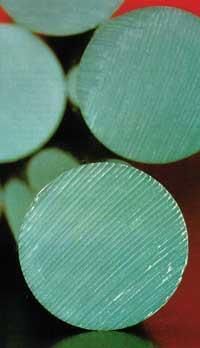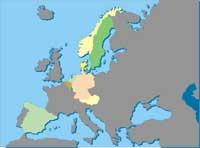Social debate on PVC
Poly (vinyl chloride) (PVC) is a widely used plastic. It is mainly used in construction to realize window frames, pipes, walls, blinds and cable coatings. It is also used for sanitary products (gloves, bottles...), toys, packaging and glasses. In production, 43% of its components are petroleum, while the other part is hydrochloric acid. And the starting point of the main debates is: Is this chlorine used harmful? Are the production, use and purpose of the material (incineration, recycling) suitable? Is PVC polluting?
We have found two opposing views on these questions, one from industry and one from environmental groups.
A seemingly quiet industry

José María Sala, spokesperson for the PVC group of ANAIP-Spanish Confederation of Plastics Entrepreneurs, recently went to Donostia to give a conference. The Chamber, invited by the Faculty of Chemistry, carried out an intense defense of poly (vinyl chloride). “The 16 most cutting-edge studies conducted in the last two years have reached the same conclusions: PVC is not polluting.
In Italy Dr. Maltoni worked with 1,200 animals analyzing glass and PVC; research conducted in the Netherlands in July 1995 was very reliable; incineration research conducted by the American Society has confirmed that PVC is not harmful; in Sweden, due to pressures that occurred, in 1995 it was banned, but production lifted this year, Parliament has. All studies indicate that PVC is not polluting. There is therefore no reason to be distressed.”
The Room considers that PVC is very durable, non-flammable, versatile, 100% recyclable, suitable for the production of numerous products and without causing damage. He says that PVC has brought to society numerous advantages because it offers good conditions from a logistical point of view. PVC is the most produced plastic in Europe. Germany is known to have great respect for the environment and is the first consumer in Europe. Italy and France follow him.
According to industry, only in Switzerland is prohibited the use of PVC packaging, but because they have very obsolete incineration plants, this is due to the great difficulties of recycling and not because PVC is polluting. The Chamber says it is for the environment and would be very happy if more high-level scientific research were done.
When analyzing the total value of any material, its life cycle must be seen, it is very important to analyze how and with what consequences the extraction of raw materials, transport, manufacture, use, transformation, disappearance and recycling is carried out. ANAIPE claims that PVC is at a relatively good level, but no complete data is available.
Boycott of environmental groups
Greenpeace says PVC is polluting. This environmental group has warned of the danger of poly (vinyl chloride) and has campaigned against this type of plastics. Other groups (Eki, Ezker Batua-Berdeak...) have also shown up against plastic.
Environmentalists say it has a very bad life cycle, which produces dioxins and phthalates. The appearance of this plastic is clean and hygienic, but according to Greenpeace “it is a cocktail of toxic products that the chemical industry introduces into our homes”. From start to finish, from production to disposal, transformation or use, the environmental organization says that PVC threatens the environment and our health: “PVC is made with chlorine and this gas is very toxic. By mixing chlorine with organic substances, organic compounds are formed.

PVC production produces thousands of tons of toxic organochlorine substances that are seriously affected by its deposition in the atmosphere or its dumping into rivers and seas. Dioxins, phthalates and other compounds damage the health of the inhabitants of the environment and poison the environment. The transport of poly (vinyl chloride) is also very dangerous, since in case of fire the PVC emits hydrochloric acid and dioxins. When PVC waste is burned in incinerators we find the same problem.”
This plastic is the most used in construction due to its low cost. But Greenpeace believes that these prices do not include the environmental impact of PVC. As an alternative they propose other materials. Environmentalists agree on the need to use more natural local products using imagination and design.
In some European countries, greens have managed to reduce the use of PVC. However, the European Union has not yet taken legal action against this plastic. According to Greenpeace data, more than 300 cities in Germany, Denmark, Luxembourg, Sweden and the Netherlands are reducing their use. Major water packaging companies such as Evian, Perrier and Vittel are rejecting PVC.
Recycling
XX. At the end of the 20th century recycling is a leading theme at all levels. It has been said that PVC is difficult and expensive to recycle. However, ANAIPE managers consider that PVC is 100% recyclable and the process is cheap and simple. It becomes white powder, using different formulations for each product.

As for plastic we have to keep in mind that we use many containers daily. Paper and glass have more tradition in recycling, but it seems that PVC is increasingly being recycled. The recycled material allows making sweaters, bags, bottles, cable coatings, shoe soles, furniture and other products. The Gipuzkoan company BERZIK, however, considers recycling of this plastic complicated. Crush, clean and centrifuge the PVC and have a spray micronizer. In addition, you need an independent recycling plant, as it is not compatible with other plastics.
In the European Union, a standard that does not exclude materials was adopted in December 1994. Funding has fallen to each State, but targets have been set for a five-year period, ranging from 50-65% of plastics to 25-45% recycling and recovery of at least 15% of materials. In Spain, 6% of materials are recycled and it is expected to reach 15% in five years. To do this, the green point system that is already being used in France will soon be used: if the container costs 30 pesetas, it is sold at 31 pesetas, which will be delivered to the recycling company, which will manage the recycling, but which will be responsible for the collection of the waste. All this will require the passage of a bill.
Percentage Weight (kg) Plastic Containers 25,8155.779,51.115.635PE HD 16,7136.113722.288PVC 5,612.103242.060PET% 3,57.563,5151.288% Tetra Brik 1941.0621.672.480% Metals 15,84.13653%What's in Euskal Herria?
In Hego Euskal Herria there are two companies producing PVC: Spanish Petroleum Company of Barakaldo and Elf Atochem of Hernani. But the residues of this plastic are not recycled here, they are sent to Barcelona for recycling.
In Gipuzkoa, a plastic recycling system has been put in place to get ahead of Spanish legislation. The third container has also been moved in some areas in Pamplona. But in other countries plastic is not recycled.

Two companies work with waste from the Sasieta Community (Beasain, Ordizia, Lazkao and Olabarria). On the one hand, the company BERZIK, created by SAIOLAN, collects the materials (through the 5th container), distributes them and classifies them. On the other hand, REMAPLAST recycles plastics.
But the manager of the latter, José Manuel Fernández, says that they do not recycle PVC because it is incompatible with other plastics. Currently, Gipuzkoa does not have enough waste to build a single PVC recycling plant, so it is sent to Barcelona. The manager of REMAPLAST believes that PVC, especially in packaging, will disappear. “The market increasingly admits less poly (vinyl chloride). The plastic of the future is poly(ethylene terephthalate), PET: 100% recyclable, does not produce toxins and is good for incineration”. Three tons of waste recycling 75% come to the factory every week.
Félix Ezkurra, from BERZIK, says that PET and polyethylene are more profitable than PVC. “PVC has a worse life cycle and once the process is finished it does not provide money.” However, it seems that the recycling of other plastics has a future in Euskal Herria. For the last months of this year, between 200 and 300 containers of three cubic meters will be installed in Donostia. Thus, it is estimated that by 2001 Gipuzkoa will receive 17% of plastic packaging. Similar systems are expected to be implemented in other provinces.





